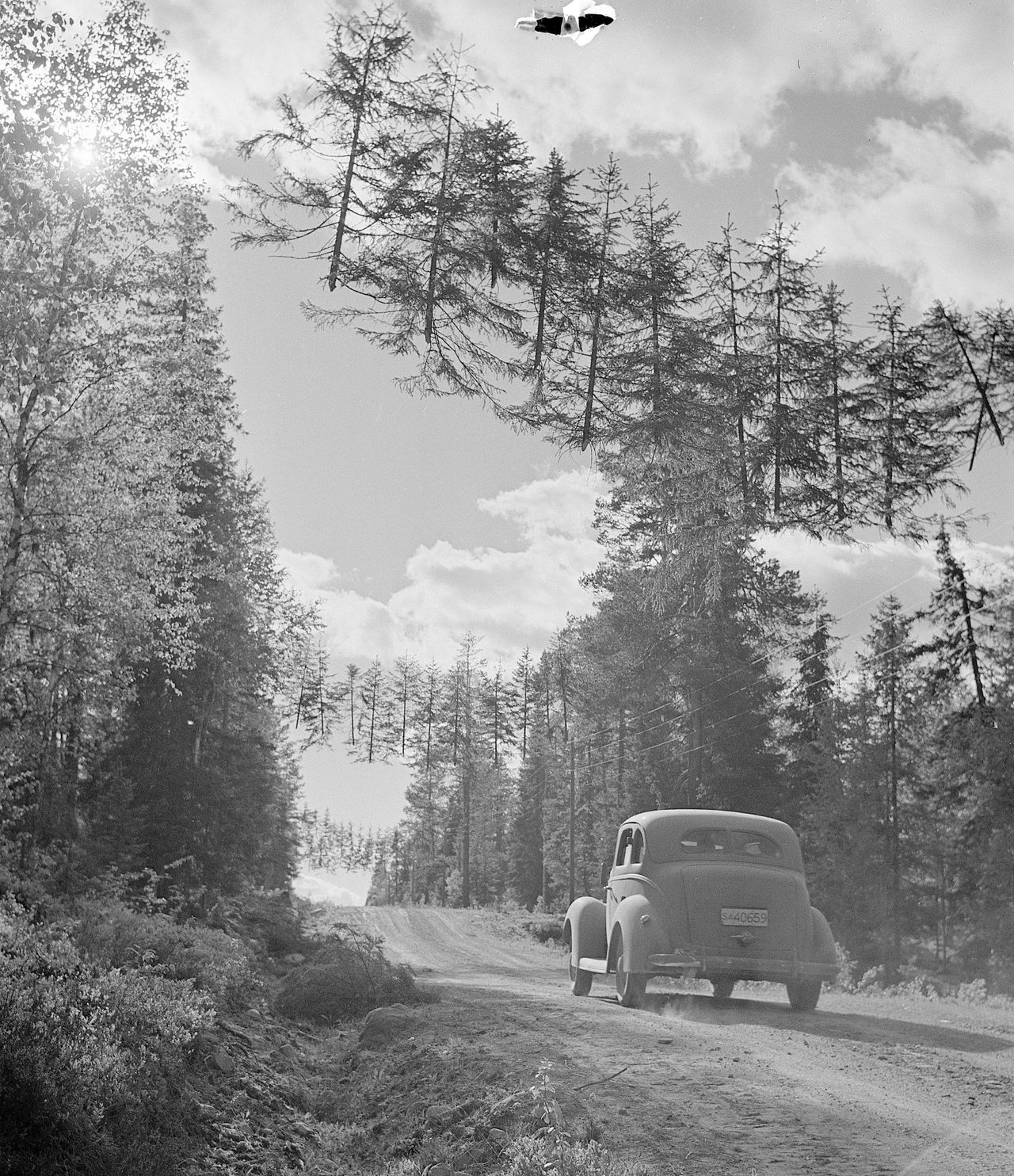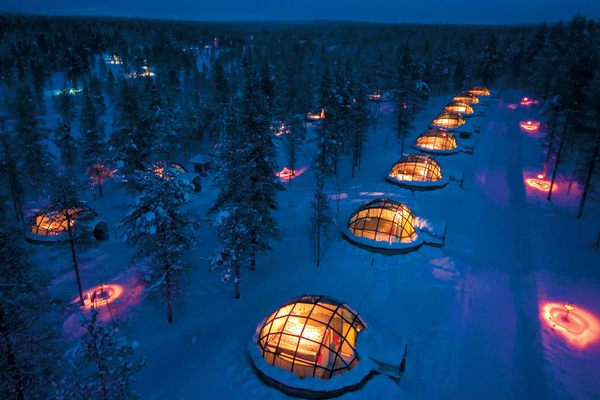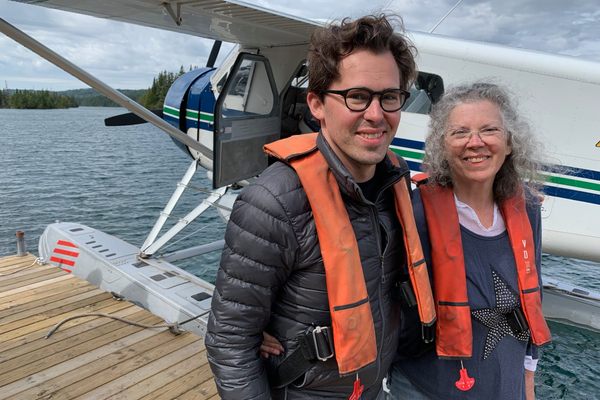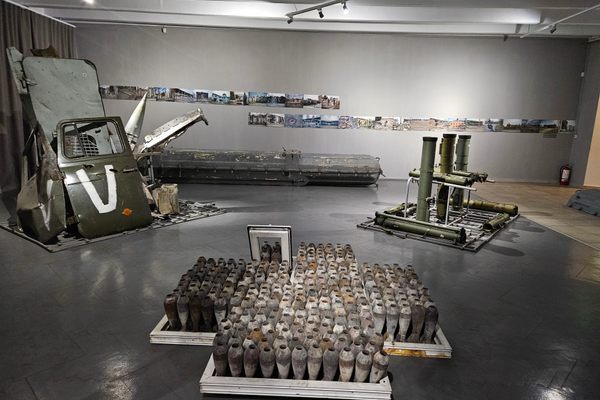How Are These Trees Floating Over a Finnish Road?
A photo archive reveals clever camouflage techniques, and highlights the strange position of NATO’s newest member, during World War II.
June 27, 1941. A Finnish Army car drives along a dirt road, a few miles from the border with the Soviet Union. Above the vehicle, a line of pines hangs in the air. It looks like an old-school photographic trick, or a surreal painting by a disciple of René Magritte, or a Photoshop clone stamp. But on the side of the road, unseen, stands a young and ambitious photographer named Osvald Hedenström, and there’s no trickery. Hedenström, who turned 28 that same day, was embedded with the Finnish Army fighting Russia during World War II. He likely wasn’t particularly impressed when he took the photo.
The reason for this is simple: During the conflict, Finland, which occupied a strange place in the conflict between Nazi Germany and Stalinist Russia, used a myriad of tricks to foil a much mightier enemy. It was common for the army to camouflage literally everything with trees and foliage to deceive Russian planes and observation towers. According to the caption that Hedenström attached to the photo, “The Finns have camouflaged the road to Raate, about 10 km from Russia, with pines hanging in the air, because right on the border there is an observation tower erected by the Russians.”
The lines of trees wouldn’t obscure the road from a plane flying overhead, but it could block the view from a tower. From a low perspective, down the road, the lines gave the illusion of an uninterrupted sequence of trees. Upon scrutiny, it is possible to see wires connected to a series of poles on the right side of the road. The whole pines were hung from such poles or other trees with cables. Due to Hedenström’s angle, viewers can’t see the attachments of the first row of trees, so they seem to be floating in the air. (The weird shape on the top of the photo is just a defect in the negative.)

The 832-mile border between Finland and Russia is today at the center of one of the major geopolitical consequences of the war in Ukraine. After the start of the conflict, Helsinki applied to join NATO, and on March 23, 2023, President Sauli Niinistö formally ratified Finland’s historic bid. Just a couple of weeks later, it became the 31st member of the military alliance.
This photo—which has appeared on social media in recent years, usually by accounts that specialize in history—is from the Finnish Defence Forces’ Photograph Archive. “War photographers were given instructions about generic topics to capture,” says Johanna Palokangas, the head of the archive. “Still, in the end they decided what to shoot and what not.” The collection contains around 160,000 images captured between 1939 and 1945, when Finland fought two separate wars against the Soviet Union: the Winter War and the Continuation War.
The similarities between the Winter War (November 1939–March 1940) and the current Russian invasion of Ukraine are striking. Stalin was concerned about a future German attack on Leningrad through Finnish territory, and he wanted to move the border further west. Then, as now, Moscow counted on a superior army, believed that defenders of the invaded country would welcome Russian troops as liberators, and thought it had sovereignty over what was once a part of its sprawling Empire. The Finns inflicted humiliating losses on the Red Army due to their advantage of terrain, skillful use of camouflage, and mastery of hit-and-run tactics. Eventually, they had to sign an exacting peace treaty, but managed to preserve their freedom and keep 90 percent of their territory.

When the conflict started, Nazi Germany was allied with the Soviet Union. As a secret appendix to the Molotov-Ribbentrop Pact (a non-aggression agreement that established the partition of Poland), Hitler guaranteed that Germany would not interfere with Russian advances in the Baltic states and Finland. “The nonintervention of Germany was a huge disappointment,” explains Henrik Meinander, a historian at the University of Helsinki, “not because Finland was fascist—the fascist party won only 4 percent of the vote in the 1939 elections— but because it hoped Germany could stop the expansion of Russia.”
Though they were politically at odds, there had been strong cultural connections between Finland and Germany (German was the lingua franca in the Baltic region), and a history of military cooperation. The Finnish Army itself had been organized by Germany during World War I, when Berlin helped Finland to obtain independence from the emerging Soviet Union.
In December 1940, after the Winter War, Germany secretly invited Finland to take part in the invasion of the Soviet Union. “The message was clear,” says Meinander. “If Helsinki had decided to remain neutral, it would have lost its independence and probably would have faced a double invasion by Germany and Russia.”

Eager to avenge their recent defeat, the Finns agreed to fight alongside the Nazis, but they never wanted to make the alliance official. After all, Hitler’s authoritarian, expansionist, genocidal regime was politically opposed to Finland’s liberal democracy. Leadership in Helsinki always tried—during and after the war—to frame its struggle against the Soviet Union as a separate conflict from Hitler’s one.
At the beginning of the next stage of the conflict, the Continuation War, in summer 1941, Finland needed photographers for its propaganda efforts. At that time, Osvald Hedenström was beginning a brilliant career in photojournalism, had just gotten married, and had founded his own photographic agency. When he received the call, he had to go to the front. “He was one of the first modern photojournalists in Finland,” says his granddaughter, Irina Wahlström, on a video call, “and was famous in the political sphere for his relentless determination to always get the best possible picture. Among his colleagues, he became legendary for using all kinds of tricks to get exclusive shots.”
In June 1941, Hedenström was embedded with a Finnish unit under German command when he found himself under the hanging trees. “The Finns didn’t have funds to buy artificial camouflage such as nets in vast quantities,” says Colonel Petteri Jouko, a military historian at Finnish National Defence University, “so they used trees, leaves, and foliage to confuse the enemy. They were accustomed to wilderness and took advantage of the forest, unlike the German soldiers operating in northern Finland.”

Hedenström’s picture was taken just two days after the Continuation War began. According to Jouko, it is possible that the camouflage had been erected to cover troops moving toward the front line before the conflict. “The Finnish offensive in this sector was initially very quick,” he says. “However, after initial progress the operations slowed down.”
Finland’s war against its old enemy was successful as long as Germany’s was. In September 1944, while the Third Reich was disintegrating, Helsinki surrendered to Moscow. Hedenström immediately returned to work and took a series of pictures that remain iconic in Finnish history. His most memorable is probably one from November 1945, when Finnish leadership was facing war-responsibilities trials in Helsinki. Photography was forbidden in the court, but he knew how to move in the halls of power: He reached a library overlooking the courtroom, made a hole in the cardboard wall panel with his knife, and captured the only photo ever taken of the trial.

“The prosecution of wartime government officials was the first step of a long self-analysis for Finland,” says Meinander. “The official version was that Finland was fighting its ‘separate’ war, and that Germany was not an ally. Only in the 1970s and the 1980s that historians started to acknowledge that it was an alliance de facto.”
After the war, Hedenström returned to his family and his brilliant career. “In 1986, at the age of 73,” writes Jorma Blomqvist in his biography, “he bought a spacious flat in (…) Spain. Every autumn and spring since then, he and his wife Elisabeth have warmed their aging bones in the Mediterranean, enjoying the blue sea and watching the sun setting behind the mountains.”

















Follow us on Twitter to get the latest on the world's hidden wonders.
Like us on Facebook to get the latest on the world's hidden wonders.
Follow us on Twitter Like us on Facebook